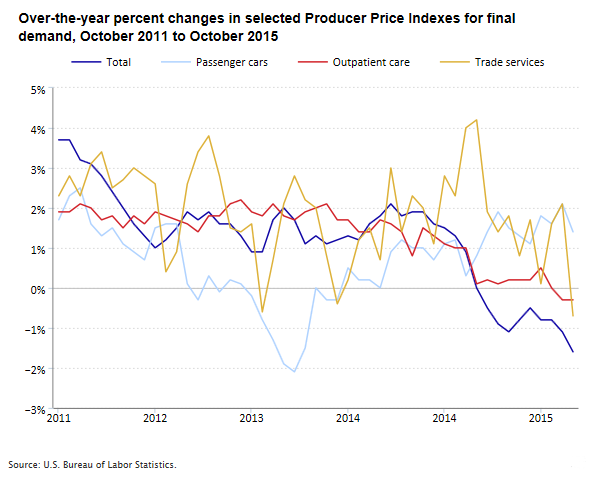Today the Bureau of Labor Statistics released the October 2015 “Producer Price Index for Final Demand and Intermediate Demand.” Let me explain what that technical-sounding title is all about. A decades-long process to improve and expand the Producer Price Index (PPI) culminated in the first monthly release of Final Demand-Intermediate Demand data in early 2014. This expansion may have made things a little more complex for the casual user. While we are exploring ways to simplify our words and concepts, I’m taking a stab at simplification in today’s blog. A rose by another name might be easier to understand.
We have 125 years’ worth of PPI data—one of the oldest measures produced by BLS. Originally called the Wholesale Price Index, the PPI measures the change in the prices that “producers” (businesses) receive for the sale of goods and services. We divide these producer prices into those paid for “final demand” and those paid for “intermediate demand.” Today I’m going to focus on final demand; in a future post I’ll examine intermediate demand.
The PPI for Final Demand measures the change in the prices that businesses receive for the sale of goods and services that are in their final form—ready to use. Sales may be to individuals (for personal consumption), to other businesses (for capital investment), to governments, or for export. The index is further divided by the type of product sold. I’ll provide a few examples—a manufacturer, a service provider, and a retailer.
In October 2015, the PPI for passenger cars rose 2.6 percent for the month and 1.4 percent from a year earlier. To measure this change in the price that auto manufacturers receive for the sale of passenger cars, we want to compare apples to apples. For example, any extra cost associated with adding mandated back-up cameras would be removed as part of a “quality adjustment” made to ensure price comparability. Simply put, auto manufacturers received 1.4 percent more for the sale of a comparable car than they did a year earlier.
As services have become a bigger and bigger part of the U.S. economy, the PPI has expanded its coverage to include many services, such as healthcare. The price that healthcare providers receive for their services, such as office exams, lab tests, and hospitalizations, include co-pays and both public and private insurance reimbursements. The PPI for outpatient care rose 0.2 percent in October 2015 but fell 0.3 percent over the year. Outpatient healthcare providers received 0.3 percent less for their services than they did a year earlier.
For wholesalers and retailers, the PPI measures the difference between the purchase price and the selling price of goods; this difference is known as the margin. Think of your local supermarket. They purchase goods for sale to customers—meat, dairy, fruits and vegetables, quinoa, toilet paper, and other items—all things you might put in your grocery basket. The difference between the price the grocer pays for these goods and the price they receive from the consumer is their margin. The PPI measures the change in that margin. In October 2015, the PPI final demand trade services fell 0.3 percent over the month and 0.7 percent from a year earlier. Wholesalers’ and retailers’ margins were 0.7 percent less than a year earlier.
The following chart shows PPI final demand price changes for selected categories over the past several years.

I hope I’ve provided a little insight into how to read and understand the monthly PPI release. In the future I’ll try to delve further into the PPI and its measure of intermediate demand. Stay tuned.
 United States Department of Labor
United States Department of Labor